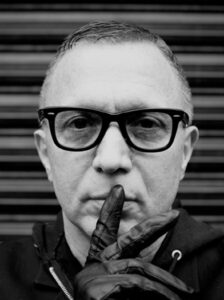Sexual Liberation Through Obscenity
“You really have to put everything into the context of the time, pre-internet and social media, and the reason we had fanzines on paper. I was just making these very crude Super 8 films that I would show underground, in queer bars and punk venues and stuff. Literally I would take a projector and show them, not thinking that they would ever be seen outside of the city.” ~Bruce LaBruce
A filmmaker, writer, and photographer Bruce LaBruce was born in Toronto in the mid-sixties and before he was thirty he had his first official film debut, but it was no ordinary film. When I first saw No Skin Off My Ass I was floored. The unapologetic exploration of sexuality felt like watching a taboo unfold before my eyes, a taboo wrapped in a political statement shot on Super 8 film. Bruce explains why it likely became a hit so quickly, “There tons of queer festivals. It was shown at mainstream film festivals as well. My second film Super 8½ was a fictionalized response to that, to me having shown myself having sex to audiences worldwide. It was not something I ever expected and I wasn’t quite prepared for the way people would look at me after I crossed a line by having explicit sex, it’s a taboo and quite often down people downed their noses. So that was probably something I wasn’t prepared for. It doesn’t mean I would have done it differently, it’s just the implications and impact that it had on my life were more extreme than I thought it would be. I didn’t really think of it, partly because I didn’t think it would be seen outside the underground.”

In 1991 when No Skin Off My Ass made its debut in Toronto it was during the pre-internet and pre-high school Gay/Straight alliances era. During this period in Toronto, the mayor at the time openly refused to proclaim Lesbian and Gay Pride Day. Those were not easy times to make or try and distribute films about queer people. As Bruce attested to in our recent interview, he wasn’t quite sure either, “The one thing I would say is that I think I was a bit naïve when I started putting myself in my early films in sexually explicit scenes. I didn’t really consider myself a pornographer at that time. I was in my 20s and I was making short experimental super eight films that had some explicit content, but it was mostly found imagery. Then I started making No Skin Off My Ass in which I performed sexual scenes. It was done very naively as well, with no crew. For part of it, I just had the camera on the tripod and my co-star was playing the skinhead was my boyfriend so it was very innocently filming yet it became a kind of cult movie around the world.”
A pioneer in filmmaking, Bruce continues to produce works that are as challenging to the status quo as they are liberating for the queer people who watch them. His take on queer politics may not be new but his influence in the areana of sexuality is as radical as it is thought-provoking. Bruce explains, “It also gave people that make pornographic work or work that has to do with sex, It kind of inspired them to see that it could be done in a way that is also artistic or romantic. It doesn’t have to be industry-style porn. Films like Hustler White, Gerontophilia, The Misandrists and L.A. Zombie further reinforce his place as a radical thinker and cultural influencer. “I think people related to it my first two films along with Hustler White because they had a big impact on them, it either gave them permission to be gay or queer because it wasn’t a typical kind of gay movie and it didn’t represent the typical gay identity politics”
As Bruce blurs the lines between pornography, art, and queer politics he’s no stranger to push-back including his films being banned outright like L.A. Zombie which was banned by The Melbourne International Film Festival only to be snatched up by the Locarno International Film Festival as well as the Toronto International Film Festival. Bruce is currently working on a trilogy of films which includes Saint-Narcisse which he is currently editing and Santo the Obscene, about a saint-like character who wanders the planet, healing people with the power of sexuality.
Santo the Obscene features Luizo Vega who went on to collaborate with Bruce on the photo exhibit Obscenity at Madrid’s LaFresh gallery. The show’s mix of religion and sexuality brought out Christian protesters who picketed for weeks attempts by the mayor to close it down and by the show’s opening the target of an explosive device which fortunately didn’t go off. Explains Bruce, “The theme for the show was the intersection between religious and sexual ecstasy and it was produced by an Argentinian performer that I had worked with, Luizo Vega, in Berlin. I did a stage adaptation of Shoeinberg’s Pierrot Lunaire [a Canadian/German film] and it was then we decided to collaborate on Obscenity. The night of the opening someone threw an explosive device through the front window of the gallery which didn’t explode but it was all over the papers again, so it was a big drama.”
Incidentally, the name Obscenity is a direct reference to the reason Canada Customs had given Bruce why they confiscated previous works of Bruce’s. But Obscenity isn’t the only film that has been met with violent or at least vigorous protests. “When I showed SkinFlick, a kind of neo-nazi porn film at the Institute for Contemporary Art in London, there were protesters outside for the entire three weeks. I’ve dealt with a lot of angry people at Q&As and things and you should never be deterred by that kind of response, it just means that maybe you’re asking the right questions.”
To say Bruce’s career has been a success solely because of his intellect would be missing his notoriously genius casting of alt-sexy queer people in both of his moving and still photo works. His knack for bringing together talented underground A-listers gives his works authenticity, street credibility, and ultimately a ballooning fanbase. To appreciate his career today it’s clear how he’s benefitted us all by pushing boundaries but in his earlier days, it wasn’t obvious that his contributions as an artist would ever be taken seriously in the mainstream. In many ways that’s the genius of his work today, it still sits just outside of people’s comfort zone, enough to provoke thought and challenge our culture’s firmly held beliefs about gender and sexuality.
In addition to having his films screen at festivals around the world, Bruce LaBruce’s work is held on permanent display at New York’s MoMA. Saint-Narcisse, the second in the trilogy, is expected in early 2020.
Photo of Bruce by Coproduction Office, LAB
Originally published in WinterPlay Magazine, 2019
